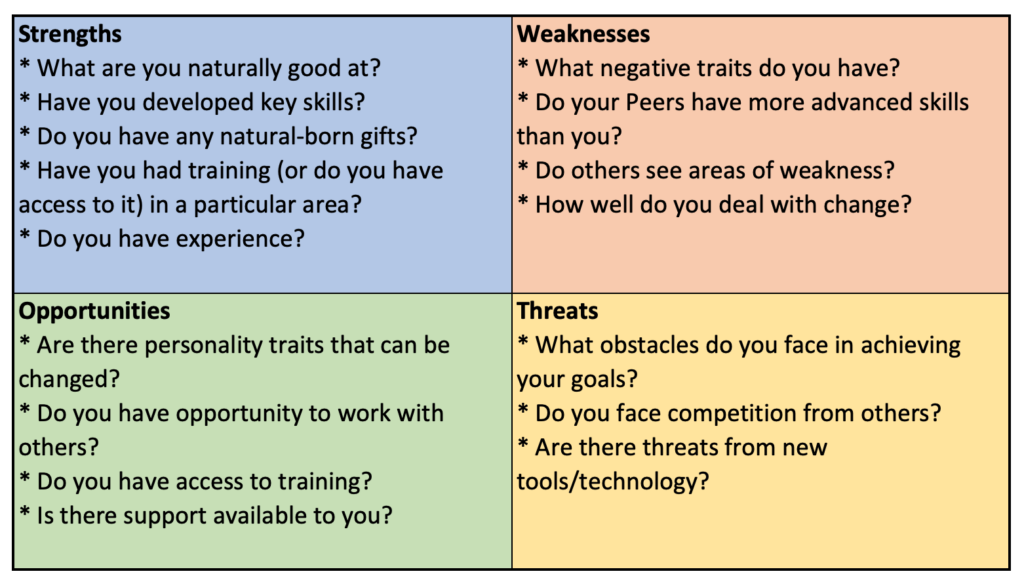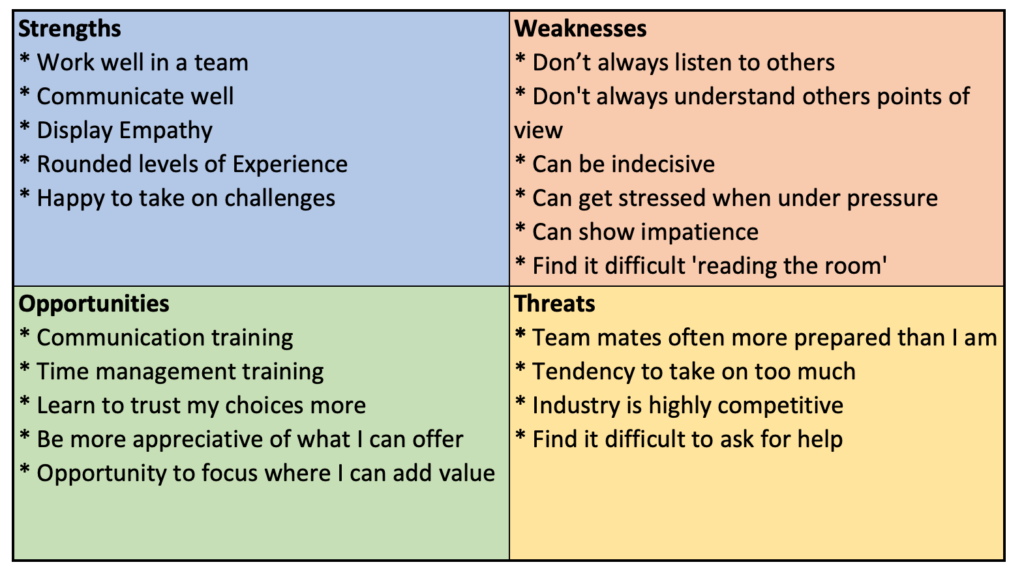
While SWOT’s are often used as a business tool, they also make an excellent medium for capturing and assessing information about our Emotional Intelligence.
In answering the question of how to do a personal SWOT analysis, we need to look in detail at the process, the tools, and our approach.
In this article, we’ll be discussing how SWOT’s can help us understand our capabilities and our weaknesses and what we can do with the results; we’ll be covering:
- What is a SWOT
- How can you use a SWOT for personal development?
- How to conduct a personal SWOT
- How to assess yourself
- Benefits of a Personal SWOT
- Issues with Personal SWOTs
What is a SWOT
SWOT’s are built around four assessment areas:
- Strengths – characteristics that provide advantage
- Opportunities – Things in our environment that can us improve
- Weaknesses – Things that create a disadvantage
- Threats – Obstacles we face that stops us from performing at our optimum.
All SWOTs have some common characteristics:
- A SWOT analysis is both an assessment & planning tool.
- SWOT’s can be produced individually or as part of an exercise with a group.
- By using a SWOT, you utilize by default a structured assessment process.
- Once you have assessed yourself, you can then utilize the results to produce a plan of actionable steps.
You can find a SWOT template within our SWOT analysis guide.
How can you use a SWOT for personal development?
We can use the SWOT for personal examination in just the same way as we’d use it as an assessment tool for business.
- We start with an objective (i.e., what do we want to achieve through the SWOT and its resultant actions).
- We carry out the process.
- We follow through with the resultant actions and assess their impact, making changes where necessary.
But what sort of objective or goal does a personal SWOT help us achieve?
- Perhaps we are seeking greater emotional intelligence?
- Perhaps we’re looking to make ourselves more competitive in the workplace;
- Perhaps we’re looking for insight into certain personality traits
- Perhaps we’re finding new ways of dealing with people we find challenging.
Whatever the goal, have one in mind when you start.
To conduct the analysis, we ask ourselves questions about each of the four examined areas. – This can include:
- What are you naturally good at?
- Have you developed skills?
- Do you have any natural-born gifts?
- What specific negative traits exist?
- Are there specific skills that you could develop, either through practice or learning?
- What weaknesses do you see?
- What weaknesses might others see?
- Are there any personality traits that could be changed?
- How do you relate to colleagues?
- Could the way you relate to colleagues change?
- Do you face particular obstacles?
- Do you face competition from others i.e., team-mates?
- Do you face threats (i.e., from certain relationships or lack of skills in certain areas)?
You can see how these questions may relate to the SWOT from the diagram below:

So, by asking the right questions, they help bring our levels of emotional intelligence into focus, helping us drive change if required.
How to conduct a personal SWOT
- Firstly it’s a good idea to develop your lines of question before commencing your SWOT; this will provide you with a clear set of inputs to work through.
- Once you have them, work through your questions, answering them as best you can.
- Use a SWOT template to capture pertinent information from your answers to the questions.
- Be both honest and objective when answering the questions – remember that this process is there to assess your emotional intelligence. Remember that by providing an incorrect answer, you’re not really helping yourself.
- Where possible, consider inviting others to comment. Perhaps provide specific areas for them to comment on using some of the questions you’ve developed, i.e., “What do you think I’m good at?”, “How well do you think I interact with others?”.
- Once you have answered your questions, assess your answers, making sure the results are accurate.
- Now look to devise your plan, develop a set of actions that:
- Leverages your strengths to make the most of your opportunities,
- Targets improving your weaknesses to help mitigate threats.
- Once you have completed your actions, you can then prioritize them and consider the timeline that you’ll aim to achieve them.
- Put some time in your diary and regularly assess your progress.
Remember that SWOT analysis will fail to be effective if you simply treat your results as a list.
Take action.
If you’re not sure how, share your results with a colleague and look for guidance.
Look to:
- Use your results
- Establish milestones that you want to achieve
- Track progress
- Review regularly.
The below table represents an example of a completed personal SWOT.

How to assess yourself
One of the most complex parts of this process is assessing yourself.
Without a doubt, reviewing your own personality traits is hard.
Here are some tips that help within the process
- Look to utilize the four categories of emotional intelligence
- Self-awareness.
- Self-management.
- Social awareness.
- Relationship management.
- Be honest with your answers.
- Remain objective
- Be critical but do bear in mind that we can often be overcritical of ourselves.
- Take yourself out of your comfort zone, don’t just use the SWOT to reinforce your existing beliefs.
- Ask yourself what makes you different/unique.
- Engage others, ask a colleague, friend, family. Ask people who are both close to you and may only have fleeting interactions.
- Don’t just look at the present; look at what the future might hold.
- Celebrate your personal strengths.
- Find examples of personal SWOT’s online and look at how aspects of these may relate to you.
One of the points recorded above describes the benefits of involving others to help contribute towards the SWOT.
Why is this important?
When reviewing emotional intelligence, we don’t always notice everything about ourselves, whether their negative or positive traits.
Including others and asking them to be honest in their appraisal can draw out things we would not have recognized on our own.
Benefits of a personal SWOT
There are several benefits to utilizing a personal SWOT
- Provides a mechanism for understanding you as an individual
- It helps you build a pathway to achieving your goals
- Helps you to build opportunity
- It helps you focus on key capabilities
- It brings attention to soft skills such as communication skills and problem-solving.
Issues with a personal SWOT
Key issues include:
- We don’t have a goal when we start the process so the results don’t matter.
- We can often be overly critical when assessing ourselves and fail to adequately capture strengths.
- We tie our view to the current state and fail to see opportunities that could be driven by change (i.e., what would the use of new tools/technology do the results?)
- We don’t choose people with insight when we reach out for help.
- We fail to follow up on actions.
Summary
A personal SWOT is undoubtedly a powerful tool that we can use to assess our emotional intelligence.
The tool is fairly easy to use, uses a standard template, and is not overly complex in terms of process.
We can build up a powerful set of actions that can utilize to help us achieve our goals.
Have you undertaken a personal SWOT? What did you think of the results? How did it help? Were there things you’d do differently next time?
We’d love your feedback. You can reach us on Twitter (https://www.twitter.com/sanbustrain) or via the comments section below.
This article is part of our Human Resources Guide.